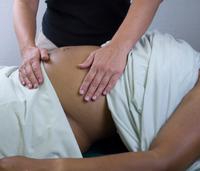Practicing relaxation techniques will help you in labour. Stress hormones can make your labour longer, and tense muscles can cause more pain. Releasing tension is the key to managing your pain and your sense of control during labour. Learn and practice relaxation skills and routines on your own and with your partner.
Relaxation techniques
Relaxing helps your uterus work
When a muscle is working very hard, it requires more blood flow to bring extra nutrients and oxygen. By the time you are ready to give birth, your uterus will be the largest and strongest muscle in your body. During its powerful contractions, your uterus will need all the blood it can get. If you are tensing other muscles, the blood flow to the uterus will be reduced and it will work less efficiently. So for a more efficient labor, try to keep your other muscles relaxed.
Progressive relaxation
When you first practice these techniques, you may find it useful to learn how to completely relax your muscles. One way to do this is progressive relaxation.
Try this:
- First, make your environment comfortable (warm, peaceful, safe and with no distractions).
- Start at one end of your body, either your head or feet.
- Work your way through all the muscle groups of your body, tensing your muscles for five seconds and then relaxing them for at least 10 to 15 seconds.
- Think about the muscles you have relaxed. Let them become soft, loose and warm.
- When you tense your muscles, breathe in.
- When you relax, breathe out. As you breathe out, imagine all the tension flowing out of your body with your breath.
- As relaxing becomes easier, try adding distractions. This is a useful thing to practice because there are many distractions during labour and birth, including contractions!
Breath/Body connection
One of the greatest tools you can use to help you relax during labour is breathing in a thoughtful way – practicing the breath/body connection. Rhythmic breathing patterns can give you tremendous power and control in your labour.
Try this
- Close your eyes and take a deep breath. Concentrate on how that breath feels as it comes in and then how it feels as you blow out. Take a second breath. This time, concentrate on your shoulders as they raise, your baby moving around, or any other changes you feel. Keep going. What are some of the things you are noticing about your body when you breathe in deeply and exhale slowly (think of your entire body)?
Use this exercise to connect to your entire body. By practicing this simple act of breathing, you will be more prepared for the sensations of labour contractions because you will be aware of how your body works in harmony with itself. You will be better able to make your body release tension and to take the rhythm of the powerful contractions in stride.
Focal point
During labour contractions, focusing your attention can keep your breathing regular and help you stay as relaxed as possible. You can focus on something you can see (like a person or something in the room), something you can hear (like your partner’s voice or the ticking of the clock) or something internal (like thinking about your cervix opening). You may want to change your focal point several times during labour.
Creative imagery
A soothing memory or picture can also help you relax. Do you have a favorite holiday location or a place you would like to visit? By imagining yourself there and using your senses to create a clear picture, you will focus less on the pain of labour.
Try this
- Imagine yourself sitting by a beautiful pond throwing pebbles into it. Count all the ripples on the water as each pebble hits.
- Imagine yourself in a swing holding your baby in your arms. Feel the warmth of your baby. Count as you swing.
If you find this type of relaxation helpful, you can find more information on imagery at the public library or bookstores.
For more ideas of how to work with your body during labour, click here to see the Alberta Health Services resource: Healthy Parents Healthy Children
Massage
Many types of massage can be helpful during labor. Self massage, or massage from a partner, can help you release tension. Some types you may wish to try:
- Light rhythmic circular stroking of your abdomen (effleurage)
- Gentle muscle massage of your shoulders, back, legs or feet
- Deep steady pressure or circular massage with fists or heels of hands on your lower back (useful if you have back labour)
- Firm long strokes down arms or thighs in time with your breathing
- Temple and head massage

Water therapy
The shower is a wonderful place to labour and can be done safely even if your amniotic membrane or ‘bag of waters’ has already broken. When the skin is stimulated by the water, the brain experiences an overload of stimuli and is less likely to notice the strength and discomfort of the uterine contractions. Some women report feeling 10 out of 10 on a pain scale outside the shower, but report feeling 4 out of 10 once in the shower.
In addition, warm water bottles or wash cloths on your lower back can help you relax. And for some women, cold packs, such as ice wrapped in a towel, offer comfort.
Once you are in active labour, a warm bath may help you relax. However, if your membranes have broken (bag of waters), do not take a bath. There is an increased risk of infection to your baby once the membranes are broken. A shower is usually a great comfort for most women and you can be in the shower whether or not your membranes have broken
Music

Many people find music relaxing. Think about what type of music helps you feel relaxed and peaceful. You can bring your music with you to the birth centre, as most rooms have portable CD players. If you prefer, you may bring your iPod or MP3 player.
Relaxation tapes
The public library and many bookstores carry relaxation audio tapes. You would need to try these ahead of time so you can know if they are helpful for you. Or maybe you could download something and use your iPod or other device.
Acupressure
Acupressure can relieve tension or pain throughout your body. During labor, your partner can apply continuous, periodic or circular pressure on acupressure points. For more information, check with your caregiver or childbirth educator.
Self hypnosis
Self hypnosis may decrease pain and help you relax. It needs to be learned before going into labour. It is taught by a number of different professionals using relaxation, visualization, distraction or attention focusing methods.
| The dance of childbirth It is believed that belly dancing originated centuries ago as a means of preparing the body for labour and easing the childbirth experience. Swaying and shifting your hips can help you feel more comfortable during contractions. It also helps the baby descend deep into the pelvis. |